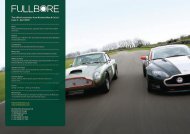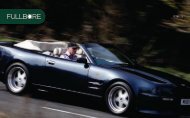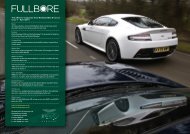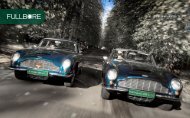AStOn mARtIn VAnqUISh AStOn mARtIn V8 EFI AStOn ... - The Seen
AStOn mARtIn VAnqUISh AStOn mARtIn V8 EFI AStOn ... - The Seen
AStOn mARtIn VAnqUISh AStOn mARtIn V8 EFI AStOn ... - The Seen
You also want an ePaper? Increase the reach of your titles
YUMPU automatically turns print PDFs into web optimized ePapers that Google loves.
FEATURE : ROAD RACER<br />
AS reguLAr fuLLbore reAderS ANd ViSitorS to our<br />
webSiteS wiLL kNow, we At NiChoLAS mee & Co Are<br />
keeN to Promote our SerViCiNg, rACe PrePArAtioN<br />
ANd reStorAtioN SerViCeS.<br />
Periodical servicing is usually a straightforward procedure, but<br />
although race prep and restorations differ greatly, there’s often<br />
an interesting tale to tell. So here’s the story of a car – specifically<br />
a 1960 Aston Martin DB4 Series 2, chassis no. DB4/411/R – and its<br />
road-spec to race-spec and back again restoration project. But<br />
first some background on the DB4 and this car in particular.<br />
the db4<br />
First unveiled at the Paris Motorshow in 1958, every major<br />
component in the ground-breaking DB4 was new. Designed<br />
by Carrozeria Touring of Milan, it employed the Superleggera<br />
(super-light) system by using alloy body panels affixed to a<br />
tubular frame. <strong>The</strong> Tadek Marek-designed 3.7-litre straight-six,<br />
dohc engine produced 240bhp and the model remained in<br />
production until June ’63, by which time there had been five<br />
distinct series and a total of 1,110 had been built. <strong>The</strong> 140mph,<br />
2+2 DB4 launched Aston Martin straight back into competition<br />
with the exotic Continental brands.<br />
15<br />
thiS db4<br />
From the 1970s DB4/411/R was owned by Nicholas Harris of<br />
Fulham, London. Prior to Mr Harris moving abroad, the car was<br />
acquired in a tired state by Nicholas Mee in November 2001, who<br />
then prepared it for racing with the Aston Martin Owners Club.<br />
<strong>The</strong> AMOC’s B1 regulations allowed few modifications and<br />
this meant a 4-litre capacity limit with standard carburetion,<br />
although an upgrade to triple SU carburetion was allowed.<br />
Other permitted modifications included uprated suspension<br />
and brakes, but the interior trim and fittings had to remain in<br />
place, and there was a minimum weight limit which prohibited<br />
the removal of road car equipment.<br />
Driven by Karsten le Blanc and Christiaen van Lanschot the car<br />
was used for some track and test days, and raced in B1 spec for<br />
two seasons, but for the 2005 season it was further modified to<br />
B2 regs. <strong>The</strong>se allowed for a reduction in weight and a 4.2-litre<br />
engine with 48mm Weber DCOE carbs. Marque specialist RS<br />
Williams built the engine using Carrillo forged steel con-rods,<br />
Cosworth competition pistons, a steel crankshaft, competition<br />
camshafts, a gas-flowed cylinder head, a strengthened engine<br />
block, tuned equal-length exhaust manifolds and a Tilton multiplate<br />
competition clutch. With a ‘soft cut’ rev limiter installed, the<br />
fuLLbore<br />
‘THE AMOc’S B1 rEGUlATIONS<br />
AllOwEd fEw MOdIfIcATIONS’






